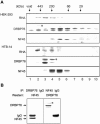The double-stranded RNA binding protein 76:NF45 heterodimer inhibits translation initiation at the rhinovirus type 2 internal ribosome entry site
- PMID: 16809299
- PMCID: PMC1489066
- DOI: 10.1128/JVI.00243-06
The double-stranded RNA binding protein 76:NF45 heterodimer inhibits translation initiation at the rhinovirus type 2 internal ribosome entry site
Abstract
Poliovirus (PV) plus-strand RNA genomes initiate translation in a cap-independent manner via an internal ribosome entry site (IRES) in their 5' untranslated region. Viral translation is codetermined by cellular IRES trans-acting factors, which can influence viral propagation in a cell-type-specific manner. Engineering of a poliovirus recombinant devoid of neuropathogenic properties but highly lytic in malignant glioma cells was accomplished by exchange of the cognate poliovirus IRES with its counterpart from human rhinovirus type 2 (HRV2), generating PV-RIPO. Neuroblast:glioma heterokaryon analyses revealed that loss of neurovirulence is due to trans-dominant repression of PV-RIPO propagation in neuronal cells. The double-stranded RNA binding protein 76 (DRBP76) was previously identified to bind to the HRV2 IRES in neuronal cells and to inhibit PV-RIPO translation and propagation (M. Merrill, E. Dobrikova, and M. Gromeier, J. Virol. 80:3347-3356, 2006). The results of size exclusion chromatography indicate that DRBP76 heterodimerizes with nuclear factor of activated T cells, 45 kDa (NF45), in neuronal but not in glioma cells. The DRBP76:NF45 heterodimer binds to the HRV2 IRES in neuronal but not in glioma cells. Ribosomal profile analyses show that the heterodimer preferentially associates with the translation apparatus in neuronal cells and arrests translation at the HRV2 IRES, preventing PV-RIPO RNA assembly into polysomes. Results of this study suggest that the DRBP76:NF45 heterodimer selectively blocks HRV2 IRES-driven translation initiation in neuron-derived cells.
Figures




Similar articles
-
Cell-type-specific repression of internal ribosome entry site activity by double-stranded RNA-binding protein 76.J Virol. 2006 Apr;80(7):3147-56. doi: 10.1128/JVI.80.7.3147-3156.2006. J Virol. 2006. PMID: 16537583 Free PMC article.
-
A peptide from autoantigen La blocks poliovirus and hepatitis C virus cap-independent translation and reveals a single tyrosine critical for La RNA binding and translation stimulation.J Virol. 2004 Apr;78(7):3763-76. doi: 10.1128/jvi.78.7.3763-3776.2004. J Virol. 2004. PMID: 15016896 Free PMC article.
-
Replication of poliovirus requires binding of the poly(rC) binding protein to the cloverleaf as well as to the adjacent C-rich spacer sequence between the cloverleaf and the internal ribosomal entry site.J Virol. 2007 Sep;81(18):10017-28. doi: 10.1128/JVI.00516-07. Epub 2007 Jul 3. J Virol. 2007. PMID: 17609276 Free PMC article.
-
Targeting internal ribosome entry site (IRES)-mediated translation to block hepatitis C and other RNA viruses.FEMS Microbiol Lett. 2004 May 15;234(2):189-99. doi: 10.1016/j.femsle.2004.03.045. FEMS Microbiol Lett. 2004. PMID: 15135522 Review.
-
Elusive Trans-Acting Factors Which Operate with Type I (Poliovirus-like) IRES Elements.Int J Mol Sci. 2022 Dec 7;23(24):15497. doi: 10.3390/ijms232415497. Int J Mol Sci. 2022. PMID: 36555135 Free PMC article. Review.
Cited by
-
Interleukin enhancer binding factor 2 is a prognostic biomarker for breast cancer that also predicts neoadjuvant chemotherapy responses.Am J Transl Res. 2018 Jun 15;10(6):1677-1689. eCollection 2018. Am J Transl Res. 2018. PMID: 30018709 Free PMC article.
-
Characterization of proteins associating with 5' terminus of PGHS-1 mRNA.Cell Mol Biol Lett. 2010 Jun;15(2):196-214. doi: 10.2478/s11658-010-0005-5. Epub 2010 Jan 28. Cell Mol Biol Lett. 2010. PMID: 20112001 Free PMC article.
-
A novel role for Gemin5 in mRNA translation.Nucleic Acids Res. 2009 Feb;37(2):582-90. doi: 10.1093/nar/gkn979. Epub 2008 Dec 9. Nucleic Acids Res. 2009. PMID: 19066202 Free PMC article.
-
Molecular strategies for the treatment of malignant glioma--genes, viruses, and vaccines.Neurosurg Rev. 2008 Apr;31(2):141-55; discussion 155. doi: 10.1007/s10143-008-0121-0. Epub 2008 Feb 8. Neurosurg Rev. 2008. PMID: 18259789 Free PMC article. Review.
-
Recombinant Poliovirus for Cancer Immunotherapy.Annu Rev Med. 2018 Jan 29;69:289-299. doi: 10.1146/annurev-med-050715-104655. Annu Rev Med. 2018. PMID: 29414253 Free PMC article. Review.
References
-
- Agol, V. I., E. V. Pilipenko, and O. R. Slobodskaya. 1996. Modification of translational control elements as a new approach to design of attenuated picornavirus strains. J. Biotechnol. 44:119-128. - PubMed
-
- Baltimore, D., and A. S. Huang. 1970. Interaction of HeLa cell proteins with RNA. J. Mol. Biol. 47:263-273. - PubMed
-
- Bradford, M. M. 1976. A rapid and sensitive method for the quantitation of microgram quantities of protein utilizing the principle of protein-dye binding. Anal. Biochem. 72:248-254. - PubMed
-
- Brummelkamp, T. R., R. Bernards, and R. Agami. 2002. A system for stable expression of short interfering RNAs in mammalian cells. Science 296:550-553. - PubMed
Publication types
MeSH terms
Substances
Grants and funding
LinkOut - more resources
Full Text Sources
Other Literature Sources
Miscellaneous

